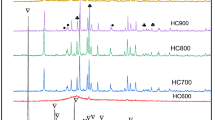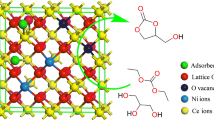Abstract
Glycerol carbonate was produced by transesterification between glycerol and different esters (dimethyl carbonate, diethyl carbonate, ethylene carbonate and propylene carbonate), using CTA-MCM-41 hybrid silica as basic catalyst. CTA-MCM-41 hybrid silica was synthesized using a non-hydrothermal method and was characterized by X-ray diffraction, thermogravimetric analysis and scanning electron microscopy. The catalyst characterizations showed that it had a hexagonal structure, catalytic sites concentration of 1.822 mmol g−1 and particle size in the range of 1–5 µm. The reactions for formation of glycerol carbonate were performed in a batch reactor, with dimethylformamide as solvent, and the products were analyzed by gas chromatography (GC-FID) and (GC–MS). Experiments were performed to study the effects of ester, temperature, catalyst percentage, and molar ratio of the reactants. The main products of the reactions with these esters were glycerol carbonate, glycidol and small amounts of glycerol monocarbonates, glycerol tricarbonate and glycidol carbonate. Cyclic-chain esters showed greater reactivity than straight-chain esters, forming fewer co-products. The reactions with straight-chain esters presented seven reaction steps, three more than the reactions with cyclic-chain esters. Straight-chain and cyclic-chain esters formed the products and co-products following different reaction mechanisms.






Similar content being viewed by others
References
Abomohra AEF, Elsayed M, Esakkimuthu S et al (2020) Potential of fat, oil and grease (FOG) for biodiesel production: a critical review on the recent progress and future perspectives. Prog Energy Combust Sci 81:100868. https://doi.org/10.1016/j.pecs.2020.100868
De Lima AL, Ronconi CM, Mota CJA (2016) Heterogeneous basic catalysts for biodiesel production. Catal Sci Technol 6:2877–2891. https://doi.org/10.1039/c5cy01989c
Singh D, Sharma D, Soni SL et al (2020) A review on feedstocks, production processes, and yield for different generations of biodiesel. Fuel 262:116553. https://doi.org/10.1016/j.fuel.2019.116553
ANP (2022) Oil, natural gas and biofuels statistical yearbook 2022. http://bit.ly/3wsTFTC
da Silva LD, Santos RC, Silva JGAB et al (2022) Direct ammoxidation of glycerol to nitriles using Mo/alumina catalysts. Reac Kinet Mech Cat 135:271–285. https://doi.org/10.1007/s11144-021-02111-8
Wang A, Xu Q, Yin H (2022) Synthesis of lactic acid starting from glycerol catalyzed by CaO-supported CuO and metallic Cu catalysts in Ca(OH)2 aqueous solution. Reac Kinet Mech Cat. https://doi.org/10.1007/S11144-022-02328-1
Eisenhart AE, Beck TL (2021) Quantum simulations of hydrogen bonding effects in glycerol carbonate electrolyte solutions. J Phys Chem B 125:2157–2166. https://doi.org/10.1021/acs.jpcb.0c10942
Rokicki G, Rakoczy P, Parzuchowski P, Sobiecki M (2005) Hyperbranched aliphatic polyethers obtained from environmentally benign monomer: glycerol carbonate. Green Chem 7:529–539. https://doi.org/10.1039/b501597a
Szori M, Giri BR, Wang Z et al (2018) Glycerol carbonate as a fuel additive for a sustainable future. Sustain Energy Fuels 2:2171–2178. https://doi.org/10.1039/c8se00207j
Hu C, Yoshida M, Chen HC et al (2021) Production of glycerol carbonate from carboxylation of glycerol with CO2 using ZIF-67 as a catalyst. Chem Eng Sci 235:116451. https://doi.org/10.1016/j.ces.2021.116451
Sonnati MO, Amigoni S, Darmanin T, Choulet O (2013) Glycerol carbonate as a versatile building block for tomorrow: synthesis, reactivity, properties and applications. Green Chem 15:283–306. https://doi.org/10.1039/c2gc36525a
Sahani S, Upadhyay SN, Sharma YC (2021) Critical review on production of glycerol carbonate from byproduct glycerol through transesterification. Ind Eng Chem Res 60:67–88. https://doi.org/10.1021/acs.iecr.0c05011
Esteban J, Domínguez E, Ladero M, Garcia-Ochoa F (2015) Kinetics of the production of glycerol carbonate by transesterification of glycerol with dimethyl and ethylene carbonate using potassium methoxide, a highly active catalyst. Fuel Process Technol 138:243–251. https://doi.org/10.1016/j.fuproc.2015.06.012
Esteban J, Fuente E, Blanco A et al (2015) Phenomenological kinetic model of the synthesis of glycerol carbonate assisted by focused beam reflectance measurements. Chem Eng J 260:434–443. https://doi.org/10.1016/j.cej.2014.09.039
Kim SC, Kim YH, Lee H et al (2007) Lipase-catalyzed synthesis of glycerol carbonate from renewable glycerol and dimethyl carbonate through transesterification. J Mol Catal B 49:75–78. https://doi.org/10.1016/j.molcatb.2007.08.007
Zhu J, Chen D, Wang Z et al (2022) Synthesis of glycerol carbonate from glycerol and dimethyl carbonate over CaO-SBA-15 catalyst. Chem Eng Sci 258:117760. https://doi.org/10.1016/j.ces.2022.117760
Bai R, Zhang H, Mei F et al (2016) Retraction: one-pot synthesis of glycidol from glycerol and dimethyl carbonate over a highly efficient and easily available solid catalyst NaAlO2 (Green Chemistry (2013) 15 (2929–2934) https://doi.org/10.1039/C3GC40855H). Green Chem 18:6144. https://doi.org/10.1039/c6gc90102f
Helwani Z, Othman MR, Aziz N et al (2009) Solid heterogeneous catalysts for transesterification of triglycerides with methanol: a review. Appl Catal A 363:1–10. https://doi.org/10.1016/j.apcata.2009.05.021
Zhang Y, Niu S, Han K et al (2021) Synthesis of the SrO–CaO–Al2O3 trimetallic oxide catalyst for transesterification to produce biodiesel. Renew Energy 168:981–990. https://doi.org/10.1016/j.renene.2020.12.132
Sulaiman NF, Ramly NI, Abd Mubin MH, Lee SL (2021) Transition metal oxide (NiO, CuO, ZnO)-doped calcium oxide catalysts derived from eggshells for the transesterification of refined waste cooking oil. RSC Adv 11:21781–21795. https://doi.org/10.1039/d1ra02076e
Miladinović MR, Krstić JB, Zdujić MV et al (2022) Transesterification of used cooking sunflower oil catalyzed by hazelnut shell ash. Renew Energy 183:103–113. https://doi.org/10.1016/j.renene.2021.10.071
Chen HX, Xia W, Wang S (2022) Biodiesel production from waste cooking oil using a waste diaper derived heterogeneous magnetic catalyst. Braz J Chem Eng. https://doi.org/10.1007/s43153-022-00257-z
Wu S, Wu Y, Sun B et al (2022) Experimental and optimization for kinetic resolution of 1-(4-(trifluoromethyl)phenyl)ethanol enantiomers by lipase-catalyzed transesterification in organic phase. Reac Kinet Mech Cat. https://doi.org/10.1007/s11144-022-02339-y
Eid JG, de Paula GM, Cardoso D (2022) Heterogeneous transesterification catalyzed by silicas containing basic sites. Mol Catal 531:112631. https://doi.org/10.1016/j.mcat.2022.112631
Martins L, Bonagamba TJ, de Azevedo ER et al (2006) Surfactant containing Si-MCM-41: an efficient basic catalyst for the Knoevenagel condensation. Appl Catal A 312:77–85. https://doi.org/10.1016/j.apcata.2006.06.035
Zapelini IW, Cardoso D (2021) Amine-grafted Na-LTA zeolite precursors as basic catalysts for Knoevenagel condensation. Microporous Mesoporous Mater 324:111270. https://doi.org/10.1016/j.micromeso.2021.111270
Wang Y, He R, Wang C, Li G (2021) Ionic liquids supported at MCM-41 for catalyzing CO2 into cyclic carbonates without co-catalyst. Reac Kinet Mech Cat 134:823–835. https://doi.org/10.1007/s11144-021-02097-3
Rath D, Rana S, Parida KM (2014) Organic amine-functionalized silica-based mesoporous materials: an update of syntheses and catalytic applications. RSC Adv 4:57111–57124. https://doi.org/10.1039/c4ra08005j
Araújo JA, Cruz FT, Cruz IH, Cardoso D (2013) Encapsulation of polymers in CTA-MCM-41 via microemulsion. Microporous Mesoporous Mater 180:14–21. https://doi.org/10.1016/j.micromeso.2013.05.010
Fabiano DP, Hamad B, Cardoso D, Essayem N (2010) On the understanding of the remarkable activity of template-containing mesoporous molecular sieves in the transesterification of rapeseed oil with ethanol. J Catal 276:190–196. https://doi.org/10.1016/J.JCAT.2010.09.015
Silva LL, Alkimim IP, Costa JPVS et al (2019) Catalytic evaluation of MCM-41 hybrid silicas in the transesterification reactions. Microporous Mesoporous Mater 284:265–275. https://doi.org/10.1016/j.micromeso.2019.04.024
Kumar A, Iwatani K, Nishimura S et al (2012) Promotion effect of coexistent hydromagnesite in a highly active solid base hydrotalcite catalyst for transesterifications of glycols into cyclic carbonates. Catal Today 185:241–246. https://doi.org/10.1016/j.cattod.2011.08.016
Ochoa-Gómez JR, Gómez-Jiménez-Aberasturi O, Maestro-Madurga B et al (2009) Synthesis of glycerol carbonate from glycerol and dimethyl carbonate by transesterification: catalyst screening and reaction optimization. Appl Catal A 366:315–324. https://doi.org/10.1016/j.apcata.2009.07.020
de Paula LNR, de Paula GM, Rodrigues MGF (2020) Adsorption of reactive blue BF-5G dye on MCM-41 synthesized from chocolate clay. Ceramica 66:269–276. https://doi.org/10.1590/0366-69132020663792862
Beck JS, Vartuli JC, Roth WJ et al (1992) A new family of mesoporous molecular sieves prepared with liquid crystal templates. J Am Chem Soc 114:10834–10843. https://doi.org/10.1021/ja00053a020
Cai Q, Lin W-Y, Xiao F-S et al (1999) The preparation of highly ordered MCM-41 with extremely low surfactant concentration. Microporous Mesoporous Mater 32:1–15. https://doi.org/10.1016/S1387-1811(99)00082-7
Khushalani D, Kuperman A, Coombs N, Ozin GA (1996) Mixed surfactant assemblies in the synthesis of mesoporous silicas. Chem Mater 8:2188–2193. https://doi.org/10.1021/cm9600945
Medeiros de Paula G, do Nascimento Rocha de Paula L, Freire Rodrigues MG (2022) Production of MCM-41 and SBA-15 hybrid silicas from industrial waste. Silicon 14:439–447. https://doi.org/10.1007/S12633-020-00831-5
Zhao XS, Lu GQ, Whittaker AK et al (1997) Comprehensive study of surface chemistry of MCM-41 using 29Si CP/MAS NMR, FTIR, pyridine-TPD, and TGA. J Phys Chem B 101:6525–6531. https://doi.org/10.1021/jp971366+
Silva LL, Alkimim IP, Vasquez PAS, Cardoso D (2017) Synthesis and properties of MCM-41 with polymerizable CADMA cationic surfactant. Catal Today 289:2–13. https://doi.org/10.1016/j.cattod.2016.06.041
Kubota Y, Nishizaki Y, Ikeya H et al (2004) Organic-silicate hybrid catalysts based on various defined structures for Knoevenagel condensation. Microporous Mesoporous Mater 70:135–149. https://doi.org/10.1016/j.micromeso.2004.02.017
Gade SM, Munshi MK, Chherawalla BM et al (2012) Synthesis of glycidol from glycerol and dimethyl carbonate using ionic liquid as a catalyst. Catal Commun 27:184–188. https://doi.org/10.1016/j.catcom.2012.07.003
de Paula LNR, de Paula GM, Cardoso D (2022) Kinetic study of ethyl esters transesterification using hybrid silica as catalyst. Reac Kinet Mech Cat 135:2427–2439. https://doi.org/10.1007/s11144-022-02258-y
Luo Q, Zeng M, Wang X et al (2020) Glycidol-functionalized macroporous polymer for boron removal from aqueous solution. React Funct Polym 150:104543. https://doi.org/10.1016/j.reactfunctpolym.2020.104543
Ricciardi M, Cespi D, Celentano M et al (2017) Bio-propylene glycol as value-added product from Epicerol® process. Sustain Chem Pharm 6:10–13. https://doi.org/10.1016/j.scp.2017.06.003
Tian P, Wei Y, Ye M, Liu Z (2015) Methanol to olefins (MTO): from fundamentals to commercialization. ACS Catal 5:1922–1938. https://doi.org/10.1021/acscatal.5b00007
Yue H, Zhao Y, Ma X, Gong J (2012) Ethylene glycol: properties, synthesis, and applications. Chem Soc Rev 41:4218–4244. https://doi.org/10.1039/c2cs15359a
Zhang M, Yu Y (2013) Dehydration of ethanol to ethylene. Ind Eng Chem Res 52:9505–9514. https://doi.org/10.1021/ie401157c
Jiménez RX, Young AF, Fernandes HLS (2020) Propylene glycol from glycerol: process evaluation and break-even price determination. Renew Energy 158:181–191. https://doi.org/10.1016/j.renene.2020.05.126
Schuchardt U, Sercheli R, Vargas RM (1998) Transesterification of vegetable oils: a review. J Braz Chem Soc 9:199–210. https://doi.org/10.1590/S0103-50531998000300002
Acknowledgements
The authors are grateful for the financial support provided by the following Brazilian agencies: Conselho Nacional de Desenvolvimento Científico e Tecnológico (CNPq, Grant #141307/2018-8) and Coordenação de Aperfeiçoamento de Pessoal de Nível Superior (CAPES).
Author information
Authors and Affiliations
Corresponding author
Additional information
Publisher's Note
Springer Nature remains neutral with regard to jurisdictional claims in published maps and institutional affiliations.
Supplementary Information
Below is the link to the electronic supplementary material.
Rights and permissions
Springer Nature or its licensor (e.g. a society or other partner) holds exclusive rights to this article under a publishing agreement with the author(s) or other rightsholder(s); author self-archiving of the accepted manuscript version of this article is solely governed by the terms of such publishing agreement and applicable law.
About this article
Cite this article
de Paula, G.M., Eid, J.G. & Cardoso, D. Converting glycerol into glycerol carbonate by transesterification with different esters: reaction steps and coproducts. Reac Kinet Mech Cat 136, 107–124 (2023). https://doi.org/10.1007/s11144-023-02349-4
Received:
Accepted:
Published:
Issue Date:
DOI: https://doi.org/10.1007/s11144-023-02349-4




